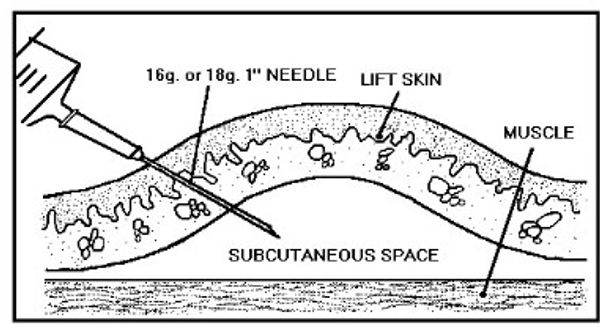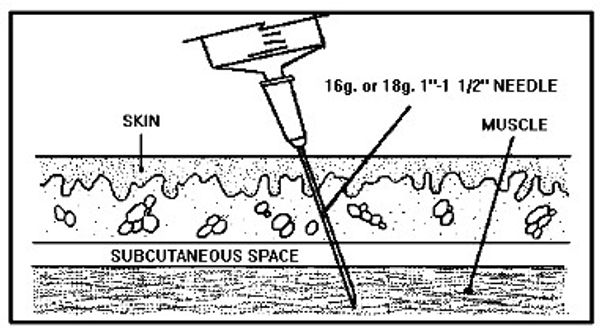- Home
- FLOCK DISPERSAL
- Equipment for Sale
- Contact Us
- 2024 Lambs
- About Us
- Pricing
- Babydoll Registries
- Feeding your Babydolls
- Record keeping
- Flock Health
- Hoof Trimming
- Shearing
- Housing your Babydolls
- Livestock Guard Animals
- Why Barn Cats
- Predator Control Fencing
- On-Farm Breeding Program
- Organic Grounds Keepers
- Embryo Collection
- Administering Medications
- Exporting Lambs
- Body Scoring and FAMACHA
- Deworming
- Babydoll Husbandry
Administering Medications
SUBCUTANEOUS INJECTIONS (SQ)
INTRAMUSCULAR INJECTIONS (IM)
INTRAMUSCULAR INJECTIONS (IM)

Subcutaneous (SQ or SC): A 1-inch needle of 18-20 gauge diameter should be used. The loose skin on the side of the neck or behind the elbow is a good location for SQ injections. These injections are given just below the skin, but not into the muscle.
Substances injected SQ are not picked up by the blood supply as quickly as with IM injections, but greatly reduce carcass blemishes.
To avoid accidental intravenous (IV) administration, pull on the plunger to make sure no blood appears in the syringe. If blood appears, pull the needle completely out and re-insert the needle in a new site.
INTRAMUSCULAR INJECTIONS (IM)
INTRAMUSCULAR INJECTIONS (IM)
INTRAMUSCULAR INJECTIONS (IM)

Intramuscular (IM): Injections given IM are picked up by the blood supply and spread to all tissues of the body very rapidly. A needle 1 to 1 ½ inches in length and 18-20 gauge in diameter is recommended for making IM injections.
The best location to give injections is in the heavy muscles of the neck. To reduce carcass damage and potential nerve damage, avoid the rear quarters whenever possible. It is best to give no more than 15 mLs at any one site.
To avoid accidental intravenous (IV) administration, pull on the plunger to make sure no blood appears in the syringe. If blood appears, pull the needle completely out and re-insert the needle in a new site.
INTRAVENOUS INJECTIONS (IV)
THE IMPORTANCE OF VACCINATION OF SHEEP
THE IMPORTANCE OF VACCINATION OF SHEEP

Intravenous (IV): Injections given IV are spread to all tissues of the body extremely rapidly. This is important in cases where the animal may require medications or fluids immediately because of dehydration or sickness. Situations of diarrhea, milk fever (hypocalcemia), grass tetany (hypomagnesemia), or pregnancy toxemia often require immediate IV fluids.
When giving injections or fluids IV, use a needle 1 to 1 ½ inches in length and 18-20 gauge in diameter. The best location to give large volume IV injections is in the jugular vein in the neck.
In lactating dairy goats, the milk vein can sometimes be used to inject small volumes of fluid. If an injection is given in a milk vein, use a small gauge needle to help reduce the possibility of excessive blood loss.
THE IMPORTANCE OF VACCINATION OF SHEEP
THE IMPORTANCE OF VACCINATION OF SHEEP
THE IMPORTANCE OF VACCINATION OF SHEEP

Vaccination is essential to the health the lamb from early life, through marking recovery, weaning and set the lamb up for life.
When the ewe is vaccinated 4 weeks pre-lambing the maternal antibodies (colostrum) is produced in the udder. When consumed by the lamb in the first 48hrs after birth these specific maternal antibodies protect the lamb from the corresponding diseases for 6-10 weeks. This is essential to protect the lamb from death and illness until their own immune system becomes into full activity.
Lambing marking and weaning are high risk times for weeks afterwards for the lamb to contract an illness, experience reduced production, and death.
Correct vaccination according to product label is imperative for effective immunity.

Click FLOCK DISPERSAL from menu bar above
for pictures and pricing of available Babydoll ewes. Limited availability. Once they're gone, they're gone!